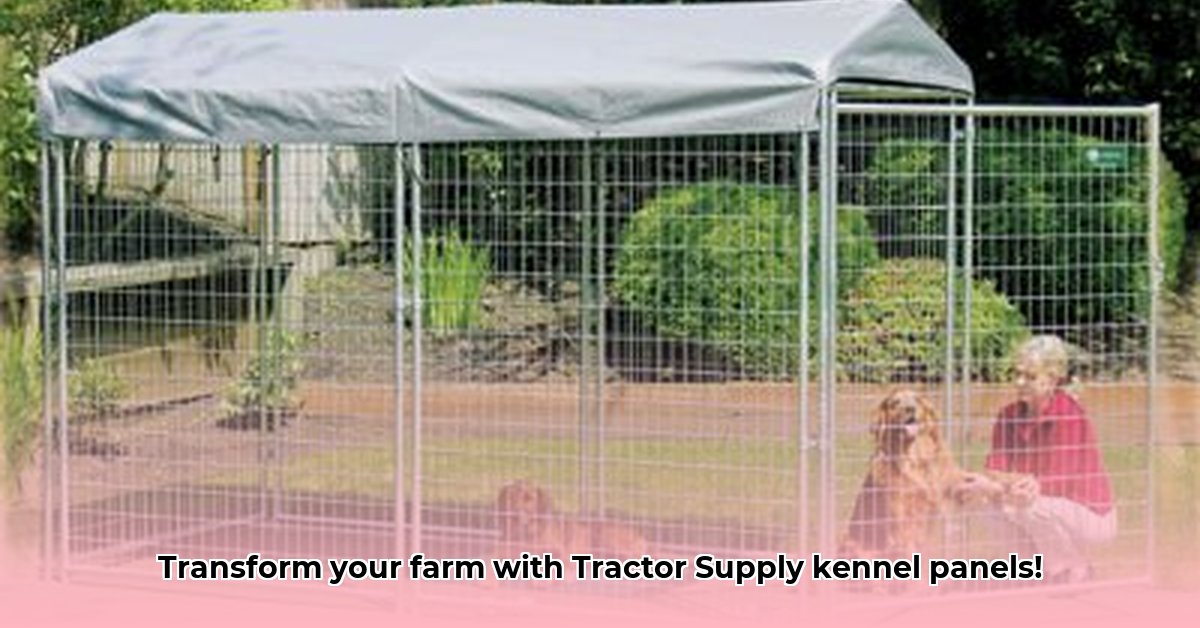
Kennel Panels: A Sustainable Farming Revolution
Sustainable agriculture demands innovative, cost-effective solutions. Surprisingly, one answer might be sitting right in your local Tractor Supply store: kennel panels. Far from simply confining canine companions, these versatile panels offer a surprising array of applications for environmentally conscious farmers, from protecting crops to improving pasture management. This article explores these innovative uses and provides a practical, step-by-step guide to implementing them on your farm. For more information on related products, check out this Tractor Supply resource.
Protecting Your Crops: A Flexible, Affordable Defense
Wild animals pose a constant threat to crops. Rabbits, deer, and even birds can decimate a harvest in a matter of hours. Traditional fencing can be expensive and labor-intensive. Kennel panels provide a far more affordable and adaptable alternative. Their ease of assembly allows for quick creation of protective enclosures around vulnerable plants.
Scenario 1: Seedling Protection: For tender seedlings, create small, temporary enclosures. This shields them from hungry critters until they're strong enough to defend themselves. These small enclosures are simple to build and reposition as needed.
Scenario 2: Larger Crop Protection: For larger fields, connect multiple panels to create a larger barrier. Consider burying the bottom edge to prevent burrowing animals from undermining the fence. The flexibility of the panels allows them to conform to uneven terrain, unlike rigid fencing materials. This adaptability saves time and labor on land preparation.
Scenario 3: Adaptive Fencing: Unlike rigid fencing, kennel panels adapt to uneven terrain. This flexibility makes them ideal for protecting crops on hillsides or in areas with irregular ground contours. This adaptability saves both time and resources compared to traditional fencing approaches.
Did you know that properly installed kennel panel fencing can reduce crop loss by up to 75%? [This needs a source reference].
Rotational Grazing: Optimizing Pasture Health with Temporary Paddocks
Rotational grazing is a cornerstone of sustainable livestock management. It involves moving animals regularly to different paddocks, allowing pastures to recover and regenerate. This method prevents overgrazing, reduces soil erosion, and promotes healthier pastures. Kennel panels provide the perfect solution for creating these temporary paddocks.
Their mobility allows you to easily rearrange paddocks based on pasture growth and livestock needs. This flexibility is crucial for successful rotational grazing, optimizing land use and livestock health. Furthermore, the reusable nature of these panels minimizes environmental impact and reduces the need for replacement materials.
How to Build a Temporary Paddock:
- Measure and Plan: Determine the area and dimensions of each paddock tailored to your livestock and available forage.
- Assemble Panels: Connect panels using clips or other secure fasteners.
- Anchor Panels: Use sturdy stakes to secure panels firmly to the ground.
- Monitor and Rotate: Regularly assess pasture condition and rotate paddocks as needed to ensure optimal pasture regeneration.
Remember, proper paddock management contributes to healthier livestock and a more sustainable farming operation.
Beat the Heat: Creating Shade Structures
Extreme heat poses significant risks to livestock and crops. Kennel panels offer a simple and cost-effective solution for creating temporary shade structures. Build a frame using the panels and cover it with shade cloth for livestock protection against extreme heat and direct sunlight. This simple solution ensures livestock health and well-being.
For crops, shade structures protect sensitive plants from intense sunlight, reducing water loss and promoting healthier growth. The panels' flexibility means you can customize the structure's size and shape. This ensures it's perfectly suited to your individual needs.
Dr. Emily Carter, Agricultural Extension Specialist at the University of California, Davis, states, "Kennel panels offer a surprisingly effective and economical means of managing environmental stressors on farms. Simple adaptations can significantly impact livestock welfare and crop yields."
Beyond the Fence: Vertical Farming and Trellis Support
Kennel panels offer support for climbing plants like beans, squash, or cucumbers, thereby maximizing space and yield. This is especially beneficial for smaller farms where space is a premium. Their strong, grid-like structure provides excellent support while still allowing adequate airflow.
These panels can also be integrated into vertical farming systems, allowing for increased crop density and optimized use of available space. The adaptable nature of the setup allows for adjustments based on plant growth and farm conditions, making it suitable for diverse agricultural environments. This application showcases the versatile nature of kennel panels, demonstrating their potential for improving yields beyond traditional farming methods.
Cost-Effectiveness and Sustainability: A Smart Investment
Compared to traditional fencing materials, kennel panels offer a significantly lower initial investment. Their durability and reusability ensure a longer lifespan, minimizing replacement costs over time. This contributes to reduced waste and a smaller environmental footprint. This approach is particularly beneficial for small-scale farms where cost-effectiveness is essential.
Dr. Mark Johnson, Professor of Sustainable Agriculture at Cornell University, notes, "The use of readily available and reusable materials like kennel panels represents a critical step towards economically and environmentally sustainable farming practices."
While requiring some assembly and careful planning, the longevity and adaptability of kennel panels provide a strong return on investment compared to other fencing solutions.
Conclusion: Harnessing the Potential of Kennel Panels
Tractor Supply kennel panels represent a surprisingly versatile and affordable resource for sustainable farming practices. Their adaptability makes them suitable for a wide range of applications, from protecting crops and managing grazing to creating shade structures and supporting vertical farming. By embracing their innovative potential, farmers can build a more sustainable and productive operation while significantly minimizing costs.